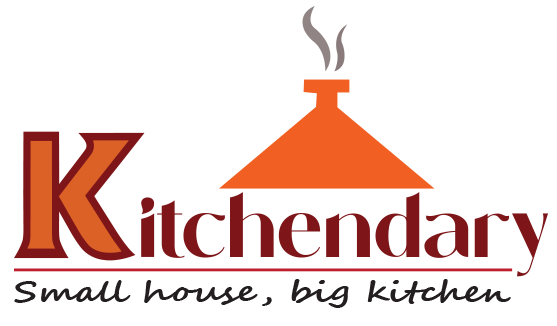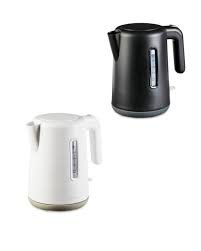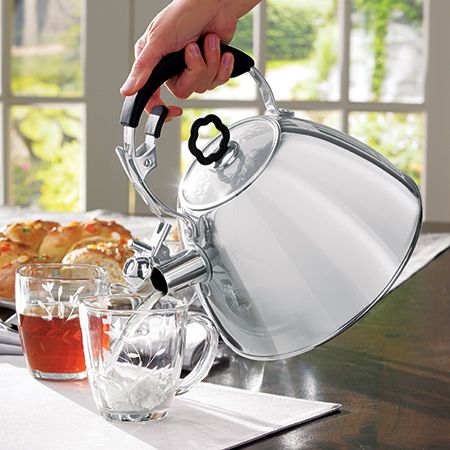Yes, not all tea kettles whistle. Some are designed to produce a whistle when the water is boiling, while others do not have this feature.
The whistling sound is produced by the steam escaping from a small hole in the kettle’s spout. This signals that the water has reached its boiling point. Tea kettles come in various designs and functionalities, and the whistling feature is not a standard across all models.
Many modern electric kettles, for example, do not produce a whistle when the water is ready. Whether a kettle whistles or not depends on its specific design and intended use. We will explore the different types of tea kettles and their features, including the whistling mechanism. Understanding these variations can help you choose the right kettle for your needs.

Credit: www.pinterest.com
The History Of Whistling Tea Kettles
Tea drinking has been a beloved tradition across various cultures for centuries. The development of tea kettles goes hand in hand with the evolution of the tea-drinking ritual. Traditional tea kettles, known for their charming designs and timeless elegance, paved the way for the iconic whistling tea kettles that are household staples today.
Evolution Of Traditional Tea Kettles
The evolution of traditional tea kettles traces back to ancient times, with the earliest evidence of their use dating back to the Tang Dynasty in China. These kettles were initially crafted from materials such as bronze, iron, and ceramic, each reflecting the unique artistry and craftsmanship of the cultures they belonged to.
As tea gained popularity worldwide, the design of traditional tea kettles diversified, with influences from various regions shaping their appearance and functionality. From the sleek cast iron tetsubin in Japan to the ornate copper samovars in Russia, these kettles were not only vessels for boiling water but also symbols of cultural heritage.
Introduction Of Whistling Mechanism
The innovation that revolutionized the traditional tea kettle into the whistling tea kettle came with the introduction of the whistling mechanism in the early 19th century. This ingenious addition allowed tea lovers to multitask without worrying about water boiling over. Upon reaching boiling point, the built-in whistle produced a melodious sound, signaling the perfect temperature for steeping tea.
With the advent of stainless steel and other modern materials, whistling tea kettles today continue to marry functionality with aesthetics, offering a blend of timeless charm and practical convenience to tea enthusiasts worldwide.
The Functionality Of Whistling Tea Kettles
When it comes to traditional tea time, the sound of a whistling tea kettle is a quintessential part of the experience. But have you ever wondered how the whistling mechanism actually works and why it’s significant? Let’s delve into the functionality of whistling tea kettles.
How The Whistling Mechanism Works
Whistling tea kettles, also known as steam kettles, feature a clever and simple mechanism for alerting users when the water has reached the boiling point. The kettle’s spout contains a small opening with a narrow passage that leads to the interior of the kettle. As the water inside starts to boil, the steam is forced through this passage at high pressure, causing the iconic whistling sound.
Significance Of The Whistling Sound
The whistling sound of a tea kettle serves a practical purpose beyond just being a charming tradition. It alerts users that the water has reached the boiling point, ensuring that the tea or coffee can be prepared at the optimal temperature. Additionally, the sound serves as a safety feature to prevent the kettle from boiling dry, as the user is reminded to promptly remove it from the heat source.
Cultural Significance Of Whistling Tea Kettles
Tea Rituals And Traditions Worldwide
Tea, a beverage steeped in centuries-old tradition, holds a special place in the hearts of people around the world. Each culture has its unique tea rituals and traditions that have become ingrained in their social fabric. The use of whistling tea kettles is often central to these customs, as the distinct sound signals the readiness of the hot water for brewing the perfect cup of tea.
Iconic Representation In Literature And Media
In literature and media, whistling tea kettles have taken on an iconic status, symbolizing comfort, warmth, and a sense of home. From classic novels to modern films, the whistle of a tea kettle evokes a sense of coziness and tranquility, capturing the essence of a cherished daily ritual. This representation has further solidified the cultural significance of whistling tea kettles in the hearts and minds of people worldwide.
Do All Tea Kettles Whistle: Exploring Variations
Tea drinking has a rich history and is a beloved tradition across many cultures. When it comes to brewing a perfect cup of tea, a whistling tea kettle is an essential companion for many tea enthusiasts. However, the notion that all tea kettles whistle when water reaches boiling point is a common misconception. Let’s explore the variations in tea kettles and the factors that influence whether they whistle or not.
Types Of Tea Kettles That Do Not Whistle
Not all tea kettles are designed to produce a whistling sound when the water reaches its boiling point. For instance, electric tea kettles often lack the traditional whistling mechanism. Instead, they are equipped with automatic shut-off features or indicator lights to signal that the water has reached the desired temperature. Similarly, stovetop tea kettles with a modern, minimalist design may not include a whistling spout.
Regional Preferences And Variations In Whistling Tea Kettles
The design and functionality of whistling tea kettles can vary significantly based on regional preferences and cultural traditions. In some countries, such as England and Japan, the sound of a whistling tea kettle is closely associated with the ritual of tea preparation. As a result, traditional stovetop kettles with intricate whistling mechanisms are favored. On the other hand, regions with a strong emphasis on convenience and modern technology may prefer electric tea kettles that offer a quick and efficient boiling process without the need for a whistling feature.
The Melodic Tradition: Music And Whistling Tea Kettles
Tea has been an integral part of various cultures around the world for centuries, and with it, the tradition of using whistling tea kettles has become a charming and practical element of the tea-making process. Their unique whistle has not only served as a signal that the water is ready, but it has also made its way into the world of music and popular culture as an iconic auditory symbol. Let’s delve into the intriguing integration of whistling tea kettles in music and their impact on artistic expressions.
Integration Of Whistling Tea Kettles In Music
Whistling tea kettles have made their mark in the world of music, creating a harmonious fusion of everyday life and artistic expression. Musicians and composers have ingeniously incorporated the sounds of whistling kettles into their compositions, adding a touch of whimsy and nostalgia to their musical creations.
Impact On Popular Culture And Artistic Expressions
The distinctive whistle of tea kettles has permeated popular culture, becoming a symbol of comfort and warmth. From movie soundtracks to live performances, the melodic charm of whistling kettles has captured the imagination of artists and audiences alike, serving as a reminder of the simple pleasures found in everyday rituals.
Modern Innovations And Future Of Whistling Tea Kettles
When it comes to the world of tea enthusiasts, the timeless appeal of a whistling tea kettle isn’t fading away. The comforting sound of the whistle signaling that the water has reached the perfect temperature has become a tradition for tea lovers worldwide. Modern advancements and contemporary designs have elevated the functionality and aesthetics of whistling tea kettles to new heights, catering to both traditionalists and those with a penchant for innovation.
Technological Advancements And Contemporary Designs
In the age of innovation, technological advancements have revolutionized the design and functionality of whistling tea kettles. Manufacturers have incorporated advanced materials and engineering to improve heat distribution, resulting in faster boiling times and enhanced energy efficiency. With the integration of smart features such as temperature control and automatic shut-off, contemporary whistling tea kettles offer unparalleled convenience for users seeking precise brewing experiences.
Sustainability And Eco-friendly Options For Tea Enthusiasts
As sustainability takes center stage, the tea kettle industry has embraced eco-friendly alternatives to cater to environmentally conscious tea enthusiasts. Manufacturers are employing sustainable materials such as stainless steel, glass, and BPA-free plastics to create eco-friendly whistling tea kettles. Additionally, the introduction of energy-efficient heating elements and eco-conscious production processes reflects a commitment to reducing environmental impact without compromising on performance.
Frequently Asked Questions For Do All Tea Kettles Whistle
Do All Tea Kettles Whistle?
No, not all tea kettles whistle. Some modern electric kettles have different indicators such as beeps or lights to signify boiling. Traditional stovetop kettles typically whistle when the water reaches boiling point, but it’s not a universal feature.
What Causes Tea Kettles To Whistle?
When the water inside the kettle boils, steam is forced through a small opening in the spout, causing the characteristic whistle. This occurs due to the design of the spout and the pressure build-up from boiling water. It’s a simple yet effective way to alert users that their water is ready.
How Do I Make My Tea Kettle Whistle?
To make your stovetop kettle whistle, ensure it has a whistle mechanism and enough water inside. Place it on the heat source and wait for the water to boil. The escaping steam will produce the whistle. Keep an ear out for the distinctive sound, and you’ll know your tea is ready.
Can I Use A Tea Kettle Without A Whistle?
Yes, you can use a tea kettle without a whistle. Many modern kettles, especially electric ones, don’t have a whistle but still effectively boil water. Keeping an eye on the boiling process or setting a timer can help you know when the water is ready for your tea.
Conclusion
Not all tea kettles whistle, but most traditional stovetop ones do. It’s a helpful feature to alert when the water has reached boiling point. However, newer electric and induction models may not have a whistle. When purchasing a tea kettle, consider your preferences and needs to find the perfect fit.




